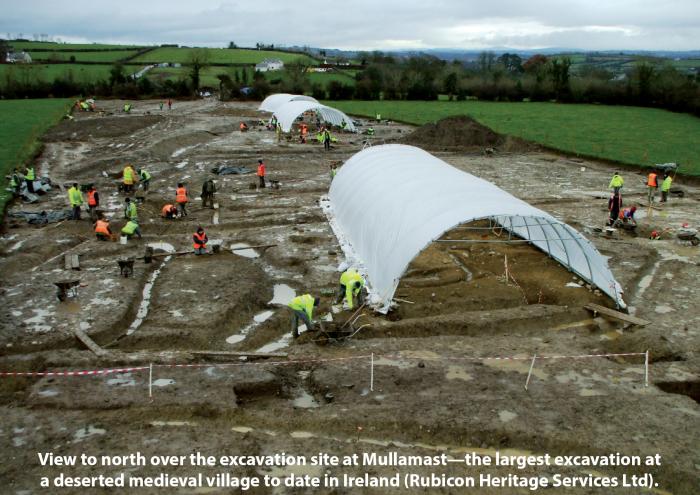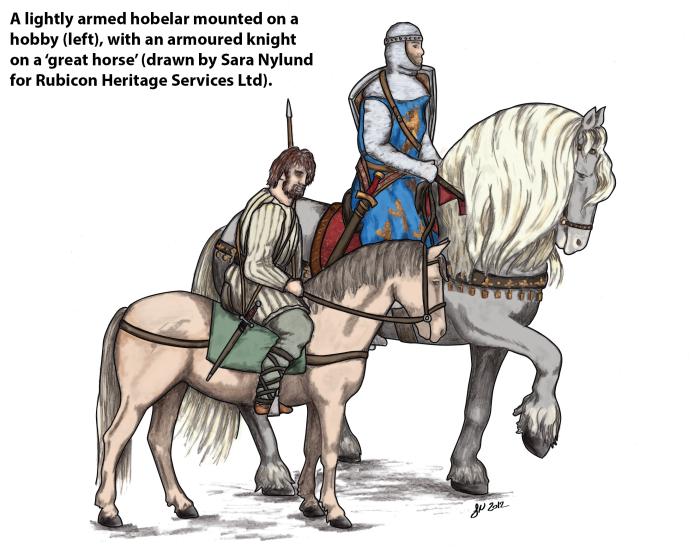The Medieval Stud Farm of Royal Mullamast: A Story to Read and Hear
By TII Archaeologist Noel Dunne

There was a pleasant end of the year event in Ballitore, Co. Kildare, on 6 December 2018, with the formal launch of not one, but two, TII archaeology books. The first book—Colonising a Royal Landscape: the history and archaeology of a medieval village at Mullamast, County Kildare by Teresa Bolger—was published in December 2017 and details the significant results of the excavation of a ‘lost’ Anglo-Norman village in advance of the construction of the M9 Kilcullen to Waterford motorway. It is the sixth book to be published in the TII Heritage series. The second book—Mullamast: the story of a medieval village produced by Abarta Heritage—is an audio book on the same excavation, which has been available to download since last August.
The formal launch of the books was the first event to be staged at The Tanyard, a new community venue in Ballitore, which lies close to the excavation site and the great royal fort of Mullamast, and within the community in which the important Anglo-Norman village is located. TII Archaeologist Noel Dunne was the Master of Ceremonies for the evening and the proceedings were introduced by Kildare Mayor, Sean Power, with other speakers consisting of the author Teresa Bolger, of Rubicon Heritage Services, Neil Jackman of Abarta Heritage, and Councillor Martin Miley. The books were formally launched by Guy St John Williams, prolific author and horse-racing historian. The large attendance included Mathew and Patsyann Farrell, on whose land Mullamast village is located; senior representatives of Kildare County Council; members of the Historic Monuments Advisory Committee for County Kildare and the County Kildare Archaeological Society; and residents from Ballitore and the surrounding district.

The archaeological excavation detailed in the books was undertaken throughout most of 2007, in advance of the construction of the M9. The discovery of the village did not come as a total surprise, as it had been documented in historical sources, but its precise location was not known. Earlier geophysical surveys and test-excavations had identified the potential village location, prior to the main phase of excavation work. This covered 2.3 ha, which is estimated at 10% of the overall area of the village, and represents the largest excavation at a deserted medieval village to date in Ireland. Hence, approximately 90% of the village remains relatively undiscovered under the sod, either side of the motorway. Undoubtedly, a subject for future archaeological study.
The village was an Anglo-Norman establishment, possibly founded by Walter de Ridlesford, a grandson-in-law of King Henry I. Its location may have been deliberately chosen, as it lies in the shadow of the ridge of Mullamast, capped by the royal fort of Maistiu. Examples of other Anglo-Norman villages established at significant existing settlements in County Kildare include Oughterard, Old Kilcullen and Moone. A pillar stone from Mullamast now housed in the National Museum of Ireland bears very fine sixth-century decoration. Grooves and polishing on the surface of the stone towards its top probably derive from sharpening and burnishing swords at inauguration ceremonies and other ceremonial events at the royal fort. This stone was chosen by the Royal Irish Academy in 2013 as one of the 100 objects that shaped Ireland.
The excavation opened a transect through the village, revealing boundary ditches, roadways, a possible village green, a number of house plots and a pond—the latter may have been used by the villagers for fish. (The exact locations of a church and a castle documented at Mullamast are still unknown to us today.) The boundary ditches along the edges of roadways and around house plots were substantial. Along with delineating lands, they also provided necessary drainage channels. Evidence for actual building structures was less clear, as the buildings were probably constructed on pads, as opposed to wall footings and foundation trenches. Cattle, sheep and pigs were reared and slaughtered for their meat, but also supplied milk, bone tools, wool fleeces and hides. Animals were also traded at fairs in nearby settlements. Bones of other animals and birds from the excavations included dog, cat, deer, pine martin, fowl, pheasant, crow, goose, mallard, grouse and squirrel. Evidence for the harvesting and processing of cereal crops, like oats, barley, wheat and rye, shows that that arable farming was also a very important aspect of village life and sustenance. A long-cross silver penny of King Edward I discovered at Mullamast was minted in Canterbury between 1294 and 1299. A most unusual find was a fourth-century AD Roman coin, possibly of Constantine the Great, which was found in the foundations of a building, perhaps inserted there for good luck by a returning pilgrim.

The distinguishing feature of the settlement was the unusually high proportion of horse remains in the animal bone assemblage and especially smaller horses corresponding in stature to the hobby. The hobby is a small, agile horse, which was prized and bred for raiding and scouting in times of war. They would have been rode by the specialist light cavalry called hobelars. They were bred, trained and exported from Ireland for use in military campaigns abroad; for example, to serve in Edward’s campaign against the Scots. The village of Mullamast may well be the first attested stud farm in the long history of horse breeding in County Kildare and a place where the villagers specialised in horses bred for warfare.
Mullamast flourished in the 13th and 14th centuries. Like other similar settlements, its decline probably resulted from a combination of factors, rather than a single catastrophic event—factors like climate deterioration, geography, the Bruce Invasion in 1315, the Black Death, and a resurgence of the native Irish. An added, possibly significant, reason for the decline of Mullamast was a weakening in the market for the hobby horse, owing to the waning popularity of the hobelars in favour of mounted longbow men.

Colonising a Royal Landscape: the history and archaeology of a medieval village at Mullamast, County Kildare can be purchased online from Wordwell Books and is also available from bookshops. The audio book can be downloaded for free from the Abarta Heritage website or accessed on the TII website.
Acknowledgements
Sincere thanks are due to Susan Waters and the Ballitore Tanyard Community Company for facilitating the launch and the countless local people for their help in the preparations. Thanks also to Pauline Fagan, Kildare County Council Librarian, Ballitore, for her great assistance. Landowner Mathew Farrell, and his family, provided great assistance and welcome to the archaeological team in the course of the excavations.
(Posted 21 December 2018)